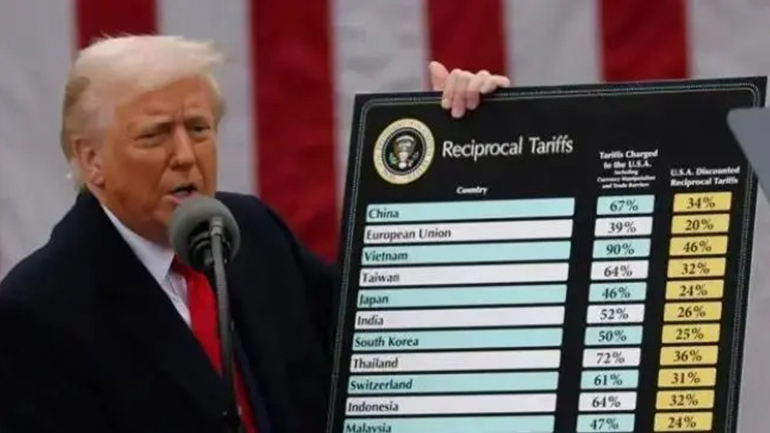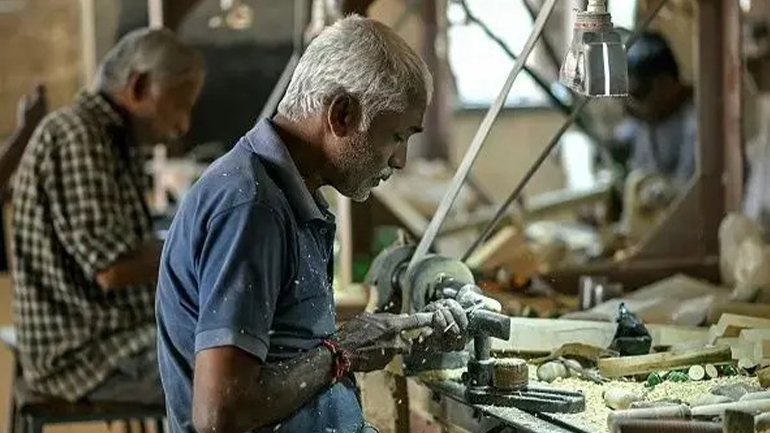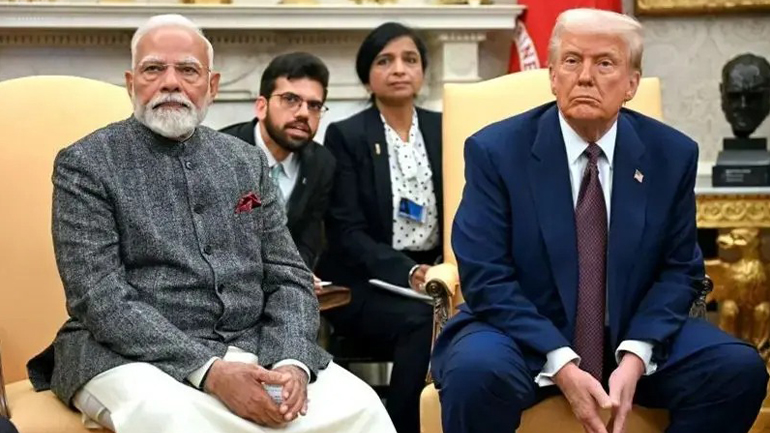

U.S. President Donald Trump has announced a 25% tariff on India, meaning that all goods exported from India to the U.S. will now face an additional 25% import tax. Alongside this tariff, President Trump also announced the imposition of extra import duties (penalties) on India due to its purchase of weapons and oil from Russia and its membership in the BRICS alliance. However, the exact rate of this additional duty has not yet been disclosed. According to Trump, the tariff and penalties against India will take effect starting August 1, 2025. This announcement comes at a time when India and the United States have been engaged in trade negotiations for several months, trying to finalize a deal. Trump had set August 1 as the deadline for India to agree to the terms. However, with no deal reached, he went ahead and announced the 25% tariff just two days ahead of the deadline. Trump has repeatedly criticized India in the past, calling it the “Tariff King”, accusing it of unfair trade practices and claiming that India has been “exploiting” the U.S. in trade relations. A tariff is a tax imposed on imported goods, calculated as a percentage of the import value, often used by countries to protect domestic industries or apply pressure in trade disputes. Now the critical question is: What impact will this 25% tariff and the additional duties have on India's economy, and will India bow to Trump’s pressure over its ties with Russia? But before we explore those economic implications, let’s look at what exactly Trump has said about India.
U.S. President Donald Trump stated that while India and the U.S. are friends, trade between the two countries has remained extremely limited over the years because India imposes some of the highest tariffs on imported goods in the world. In a post on Truth Social, Trump wrote: "India imposes stricter and more economically unfair trade restrictions than any other country. In addition, it is buying large amounts of defense equipment from Russia. At a time when the world wants Russia to stop the violence in Ukraine, India, along with China, has become one of the largest buyers of Russian energy." Trump continued, "This is unacceptable. India will have to pay the price for these actions. It will face a 25% tariff along with an additional penalty, both of which will come into effect on August 1, 2025." Later, when asked what this additional penalty would be and whether it would apply to other countries too, Trump responded: "India is a member of BRICS, which is essentially an anti-American group. BRICS is attacking the U.S. dollar, and we will not allow anyone to attack the dollar." He clarified that the extra penalty was being imposed on India because of its membership in BRICS and the trade imbalance in its relationship with the U.S. It’s worth noting that BRICS positions itself as an alternative to the Western-led model of global governance. Its core members include China, Russia, and India. Trump added, "Prime Minister Modi is a good friend of mine, but he's not doing much business with us. India sells a lot to us, but doesn’t buy from us—and the main reason is the extremely high tariffs India places on imports—perhaps higher than any country in the world." He said discussions with India were ongoing and full details would be released by the end of the week. According to data from the World Trade Organization (WTO), the average import duty in the U.S. is 2.2%, in China 3%, in Japan 1.7%, while India imposes a 12% tariff on U.S. products—much higher than other major economies. Just two days before the deadline for the U.S. reciprocal tariffs policy, Trump signaled that India could face further tariff hikes. He remarked that a trade agreement with India had not yet been finalized. According to Trump, India has placed higher tariffs on the U.S. than on any other country, and under his administration, that would no longer be tolerated. Speaking aboard Air Force One, Trump indicated that India’s efforts to negotiate lower tariffs had so far failed. Previously, Trump also warned that countries unwilling to enter bilateral trade deals with the U.S. would face tariffs ranging from 15% to 20%.

India already imposes high import taxes on foreign goods, and any further increase could pose a serious threat to the country's economy. Although India’s exports have grown, its share in the global market remains just 1.5%, which makes tackling its trade deficit even more complex and difficult for New Delhi. In March this year, Rajeshwari Sengupta, affiliated with the Indira Gandhi Institute of Development Research, "We need to boost our exports, and in such a scenario, this tariff war is not going to help us. China can withstand a trade war because of its massive export volume, but we hold only a small share in the global market." She added, "Any trade dispute will harm us more than it harms other countries." India has reduced tariffs on certain imported items such as bourbon whiskey and motorcycles, but even then, the United States still suffers a $45 billion trade deficit with India, which President Trump is eager to reduce.

Dr. Rajan Kumar, Associate Professor at the Centre for Russian and Central Asian Studies at Jawaharlal Nehru University (JNU) in Delhi, if Trump increases pressure on India regarding oil imports, India might show some flexibility. According to him, this flexibility could mean reducing its current oil imports from Russia, which account for 40% of India's total crude purchases, down to 20%, in an attempt to appease Trump. India’s Petroleum Minister Hardeep Singh Puri also hinted at this possibility earlier this month. At the Energy Dialogue 2025 held in New Delhi, Hardeep Puri stated, “We are not under any pressure. India’s oil imports are not dependent on any one country. We are not worried about this issue. If something arises, we will deal with it. There is no issue with oil supply.” This indicates that India has alternative sources for oil supply beyond Russia. But the real question remains: what will India do about defense imports? Dr. Rajan Kumar explains, “This is the biggest challenge. India will not yield to Trump’s threats regarding defense equipment purchases. Trump wants India to buy weapons from the U.S. instead of Russia. But India won’t comply, because Russia not only sells weapons to India—it also shares technology. The U.S., on the other hand, sells weapons without offering technology transfer.” He adds, “Another important factor is that public opinion in India is increasingly turning negative toward Trump and the U.S., especially after ‘Operation Sindoor’. And in a democracy, no government can afford to completely ignore public sentiment.”
In 1971, India and Pakistan fought a 13-day war, during which the Soviet Union was the only major power to openly support India. In August 1971, India’s then-Prime Minister Indira Gandhi signed the Treaty of Peace, Friendship, and Cooperation with the Soviet Union. Under this treaty, the USSR guaranteed that if war were imposed on India, it would not only offer diplomatic backing but also support India with military aid. Given this long-standing relationship, Russia is still considered a trusted ally of India. In contrast, the United States has historically favored Pakistan over India, especially during the Cold War. This raises an important question: How will the recent U.S. threats affect India’s ties with Russia? Defense analyst Rahul Bedi, “India has very limited alternatives to Russia in the field of defense cooperation. Even today, 60–70% of India’s military equipment is of Soviet or Russian origin. India is heavily dependent on Russia for the maintenance, repair, and supply of spare parts for this equipment. Even if India stops buying new weapons from Russia in the future, maintaining its existing arsenal without Russian support will be nearly impossible for at least the next decade.” But the challenge goes beyond defense logistics. If India gives in to U.S. pressure and distances itself from Russia, it could lead to greater Russian dependence on China, which poses a strategic threat to India. There’s also the risk that Russia might strengthen ties with Pakistan, adding another layer of complexity for Indian foreign policy. Russia’s increasing reliance on China is not in India’s interest. As of now, 47% of Russia’s total oil exports go to China, and Moscow has few major alternatives left. In this evolving geopolitical environment, India faces the difficult task of balancing its long-term defense partnership with Russia while managing its strategic relationships with the U.S. and other global powers.
Defense analyst Rahul Bedi firmly rejects the idea that the United States could replace Russia as India's defense partner. He states, “I don’t believe the U.S. can be a viable substitute for Russia in India's defense strategy. If no agreement is reached between India and the U.S. regarding arms procurement, India would face a highly complex situation. Integrating new defense equipment into the military system is both expensive and time-consuming. India has been using Soviet or Russian weapons since the 1960s, and suddenly replacing them with American ones wouldn’t be easy.” Rahul Bedi further explains, “Currently, the Indian military does operate some U.S.-made attack helicopters, heavy helicopters, and transport aircraft, but these were only introduced after 2010 or 2011. Now, after 15 years, they’ve been fully integrated into the system. However, buying American arms as a substitute for Russian ones today would be extremely costly, requiring significant resources for integration, military training, maintenance, and servicing.” But the challenge goes beyond technical training or logistical support—it’s also about trust. According to Dr. Rajan Kumar, India is unlikely to fully trust the U.S., no matter how many assurances it offers. “When India conducted nuclear tests, it was the U.S. that imposed sanctions, not Russia. Historically, India has never fully trusted the United States, and that’s why public sentiment in India often favors Russia.” “Furthermore, U.S. policy changes drastically with every administration, while Russia under Vladimir Putin has provided India with consistent support over the past 23 years,” he adds. Dr. Kumar continues, “Regardless of criticisms about Russian democracy, for India, Russia—especially under Putin—has been a stable and beneficial strategic partner.” India is already deeply concerned about the growing alliance between China and Pakistan. In such a scenario, India cannot risk Russia drifting into that alliance bloc. Moreover, distancing itself from Russia would jeopardize India’s key geopolitical and economic projects—such as the Chabahar Port in Iran and the North-South Transport Corridor, both of which require Russia’s cooperation. Dr. Rajan Kumar concludes that upsetting Russia would not only disrupt India's defense system but also damage its broader regional diplomacy and infrastructure ambitions.

Powered by Froala Editor